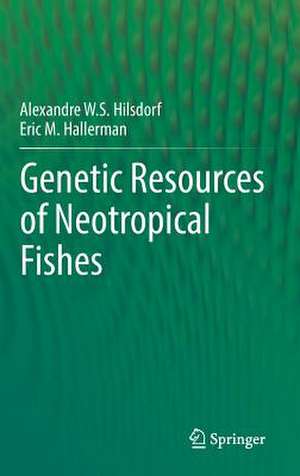Genetic Resources of Neotropical Fishes
Autor Alexandre W. S. Hilsdorf, Eric M. Hallermanen Limba Engleză Hardback – 26 iun 2017
| Toate formatele și edițiile | Preț | Express |
|---|---|---|
| Paperback (1) | 943.43 lei 6-8 săpt. | |
| Springer International Publishing – 22 aug 2018 | 943.43 lei 6-8 săpt. | |
| Hardback (1) | 949.42 lei 6-8 săpt. | |
| Springer International Publishing – 26 iun 2017 | 949.42 lei 6-8 săpt. |
Preț: 949.42 lei
Preț vechi: 1157.82 lei
-18% Nou
Puncte Express: 1424
Preț estimativ în valută:
181.70€ • 188.99$ • 149.100£
181.70€ • 188.99$ • 149.100£
Carte tipărită la comandă
Livrare economică 14-28 aprilie
Preluare comenzi: 021 569.72.76
Specificații
ISBN-13: 9783319558363
ISBN-10: 3319558366
Pagini: 254
Ilustrații: XIII, 258 p. 64 illus., 40 illus. in color.
Dimensiuni: 155 x 235 mm
Greutate: 0.56 kg
Ediția:1st ed. 2017
Editura: Springer International Publishing
Colecția Springer
Locul publicării:Cham, Switzerland
ISBN-10: 3319558366
Pagini: 254
Ilustrații: XIII, 258 p. 64 illus., 40 illus. in color.
Dimensiuni: 155 x 235 mm
Greutate: 0.56 kg
Ediția:1st ed. 2017
Editura: Springer International Publishing
Colecția Springer
Locul publicării:Cham, Switzerland
Cuprins
Acknowledges.- Preface.- Introduction.- 1. Genetic Resources: What are genetic resources and their importance for food production?.- 1.1. About biological diversity.- 1.2. What are biological resources, genetic resources, and genetic heritage?.- 1.3. Genetic resources and food production.- 1.4. Animal genetic resources.- 1.5. Genetic resources of freshwater fishes in the world.- 1.6. Genetic resources for aquaculture species.- 1.7. Biogeography of fishes globally.- 1.8. Biogeography of fishes in the Neotropical region.- 1.9. Fish genetic resources in the Neotropical countries.- 1.10. Threats to FiGR.- 1.10.1. Damming.- 1.10.2. Fish introductions and hybridizations.- 2. Characterization of Genetic Resources.- 2.1. The genetic structure of populations.- 2.2. Population and stock concepts for FiGR management.- 2.3. Genetic variation and its importance for FiGR.- 2.4. Genetic markers used in the characterization of fish populations.- 2.5. Evolution in use of population-based genetic markers studies of Neotropical fishes.- 2.5.1. Allozyme Markers.- 2.5.2. Mitochondrial DNA-based Markers.- 2.5.3. RAPD (Random Amplified Polymorphic DNA).- 2.5.4. Minisatellites and microsatellites.- 2.5.5. Single Nucleotides Polymorphism.- 3. Genetic Resources of Freshwater Neotropical Fishes.- 3.1. Introduction.- 3.2. Biologically defined units for management of aquatic organisms.- 3.3. Genetic evaluation of Neotropical fishes.- 3.4. Summary and Prospects.- 4. Prospective Views and Recommendations.- 4.1. Explore and exploit quantitative variation in native Neotropical species for aquaculture.- 4.2. Programmatic survey population genetic variation of critical species.- 4.2.1. Phylogenetic characterization of all lineages.- 4.2.2. Range-wide characterization of population genetic differentiation.- 4.2.3. Application to management.- 4.3. Recommended future work.- 4.3.1. Landscape genetic assessment of genetic variation.- 4.3.2. Seeking adaptation-related genetic variation.- 4.3.3. Landscape genomics.- 4.3.4. Genetically cognizant hatchery-based fishery supplementation.- About the Authors.- Glossary.- Index.
Notă biografică
Alexander Wagner Silva Hilsdorf is an Associate Professor in the Biotechnology Unit at the University of Mogi das Cruzes in Brazil. There he established the Laboratory of Aquatic Organism Genetics and Aquaculture, which uses molecular markers to investigate problems in fish breeding, fisheries monitoring, population genetics and conservation.
Eric Hallerman is a Professor of Fish Conservation at Virginia Tech University in the United States. His research interests include population genetics of aquatic organisms, aquaculture, and biotechnology. He is a Fellow of the American Fisheries Society.
Eric Hallerman is a Professor of Fish Conservation at Virginia Tech University in the United States. His research interests include population genetics of aquatic organisms, aquaculture, and biotechnology. He is a Fellow of the American Fisheries Society.
Textul de pe ultima copertă
The aim of this book is to systematize and discuss population genetic studies of freshwater fish in a region that harbors the greatest diversity of species among all inland water ecosystems. This volume explores the genetic evaluation for a number of orders, families and species of Neotropical fishes, and provides an overview on genetic resources and diversity and their relationships with fish domestication, breeding, and food production.
Caracteristici
Information about genetic resources of Neotropical fishes available Analysis of genetic of economically important Neotropical fish species Rich material for students and fish scientists worldwide to know more about the genetic value of the richest fish diversity in the world Includes supplementary material: sn.pub/extras





